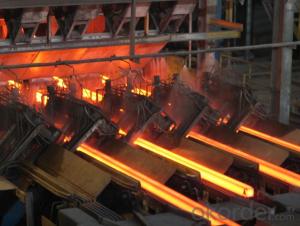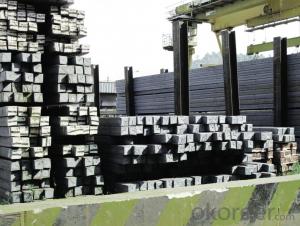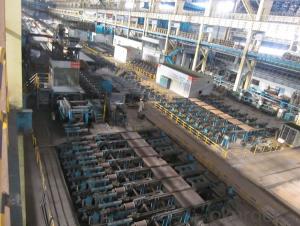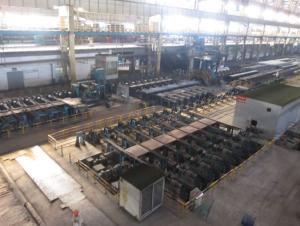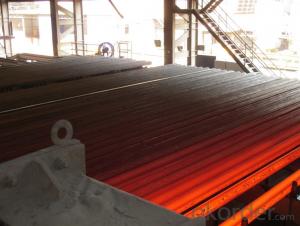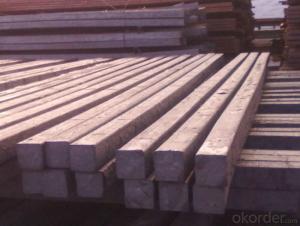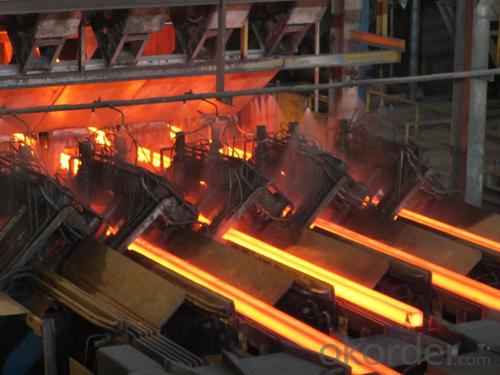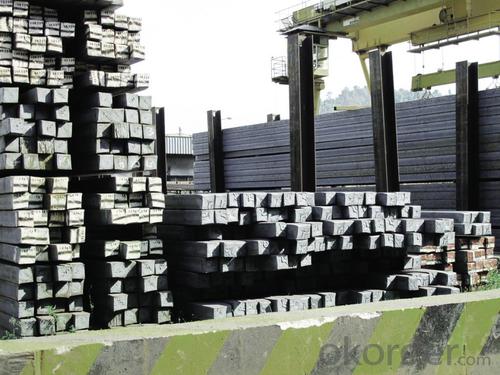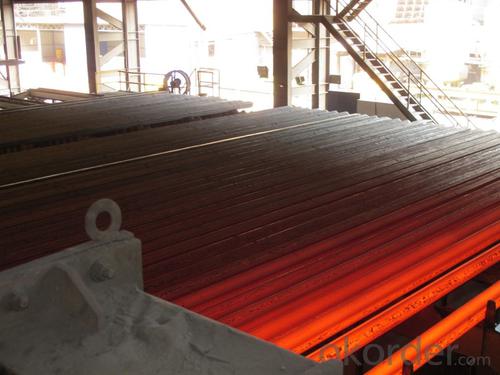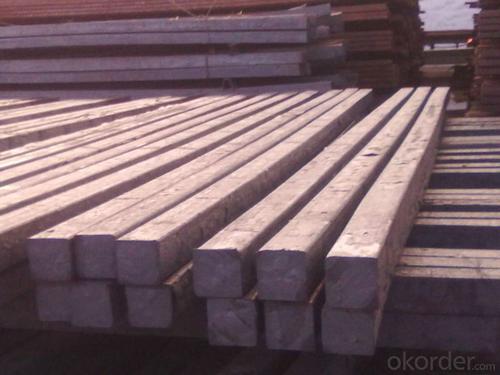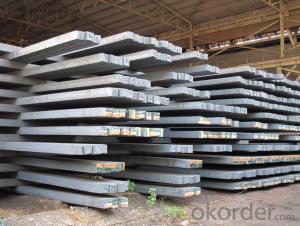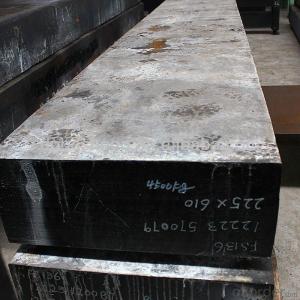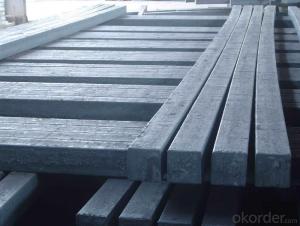Hot Rolled Steel Billet 3SP Standard 125mm
- Loading Port:
- Shanghai
- Payment Terms:
- TT OR LC
- Min Order Qty:
- 100 m.t.
- Supply Capability:
- 10000 m.t./month
OKorder Service Pledge
OKorder Financial Service
You Might Also Like
Structure of Hot Rolled Steel Billet 3SP Standard 125mm

Description of Hot Rolled Steel Billet 3SP Standard 125mm
Prepainted Rolled steel Coil is a kind of coated steel coil/sheet. With the cold rolled steel of different strength and thickness as substrate, it is produced through applying Al-Zn coat on both faces by hot dip process. In its coating, Al accounts for about 55%, Si 1.6%, while the remaining is Zn. Aluminum zinc coils enjoys both the physical protective feature and durability of Al and the electrochemical protective property of Zn. And its surface has bright silver color and regular embossed-like figure, which are highly decorative. RAL Scale Z35 Prepainted Rolled Steel Coil for Construction Roofing

Main Feature of Hot Rolled Steel Billet 3SP Standard 125mm
1.Corrosion resistance: It mainly depends on the zinc protection. When the zinc being worn,
2. Heat resistance: steel sheet has excellent heat resistance, can withstand high temperatures over 300 centigrade, and is similar with aluminized steel high temperature oxidation resistance. It often used in chimney pipes, ovens, fluorescent lighting device and the device cover.
3. Heat reflective: Galvanized steel plate heat-reflective high rate is twice as galvanized steel, often used to make insulation materials. RAL Scale Z35 Prepainted Rolled Steel Coil for Construction Roofing
Applications of Hot Rolled Steel Billet 3SP Standard 125mm
1. Construction and building: roofing; ventilating duct; handrail; partition panel;etc.
2. Electric appliance: refrigerator; washing machine; refrigerator; DVD;etc.
3.Transportation: oil tank; gas tank;road sign; etc.
4.Agriculture constructions :barn; etc.RAL Scale Z35 Prepainted Rolled Steel Coil for Construction Roofing
5.Others:vending machine; game machine; auto parts spare parts etc.
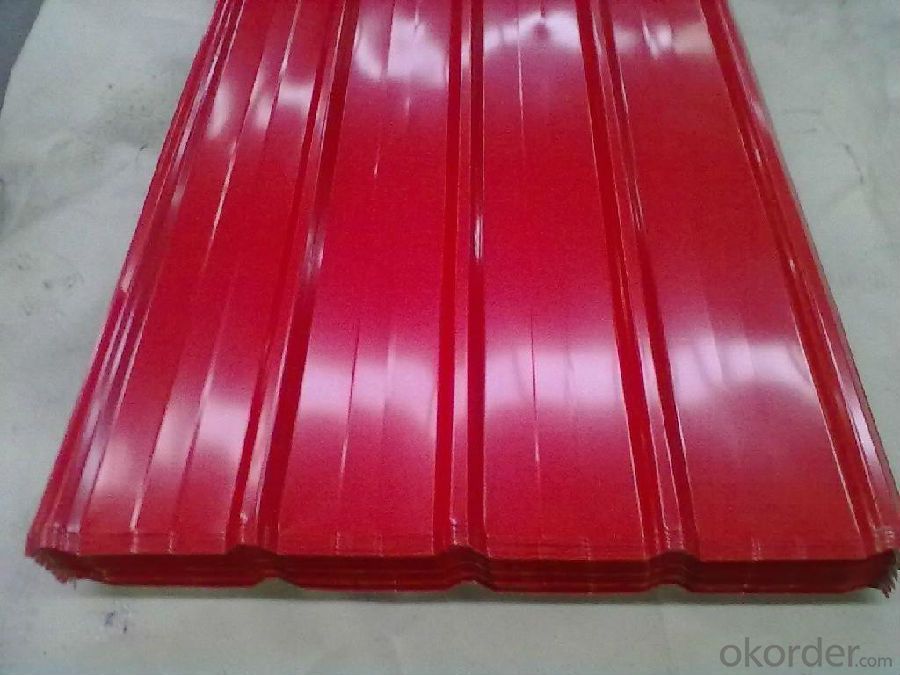
Specifications of Hot Rolled Steel Billet 3SP Standard 125mm
Product | Hot Rolled Steel Billet 3SP Standard 125mm |
Material Grade | SGCC / SGCH / DX51D+AZ, etc |
Thickness | 0.5-3.0mm |
Width | 700-1500mm |
Tolerance | Thickness: +/-0.02mm , Width:+/-2mm |
Zinc-coating | AZ30-150g/m2 |
Technique | Raw material: Hot rolled steel coil --> Cold rolled_>hot dipped galvalume |
Surface | Dried, Chromated, Unoiled,RAL Scale Z35 Prepainted Rolled Steel Coil for Construction Roofing |
Spangle | Regular spangle , small spangle, zero spangle |
ID | 508MM 610MM |
Coil weight | 25MT max |
Export package | Cardboard inner sleeves, Waterproof paper, galvanized steel covered and steel strip packed |
FAQ of Hot Rolled Steel Billet 3SP Standard 125mm
We have organized several common questions for our clients,may help you sincerely:
1. What is the minimum order quantity ?
Our MOQ is 100 mt for each size each specification. Usually we can offer discount if can buy large QTY once. RAL Scale Z35 Prepainted Rolled Steel Coil for Construction Roofing
2. How long can we receive the product after ordering?
Our general delivery time is 30 days after confirmation, but so some special orders, we have offer special delivery time
3. How to guarantee the quality of the products?
We have established the international advanced quality management system ,every link from raw material to final product we have strict quality test;We resolutely put an end to unqualified products flowing into the market. At the same time, we will provide necessary follow-up service assurance.
4. What is the payment?
We accept T/T, L/C
- Q: What are the different methods of steel billet surface coating?
- There are several methods of steel billet surface coating, including hot-dip galvanizing, electroplating, powder coating, and thermal spray coating.
- Q: What is the role of steel billets in the manufacturing of structural steel bridges?
- Steel billets play a crucial role in the manufacturing of structural steel bridges as they serve as the primary raw material for the production of steel beams and other structural components. These billets are heated and then shaped into desired forms through processes like rolling or forging. Their high strength and durability make them ideal for constructing the load-bearing elements of bridges, ensuring the structural integrity and longevity of the final bridge product.
- Q: How are steel billets used in the production of mining conveyors?
- The production of mining conveyors heavily relies on steel billets, which are essential for creating sturdy and durable components. Mining conveyors are responsible for transporting bulk materials like coal, ore, and gravel across long distances. To withstand the harsh conditions of a mining environment, these conveyors require robustness and durability. Conveyor rollers, crucial for the conveyor system's functionality, are manufactured using steel billets as the raw material. These rollers provide support and guidance to the conveyor belt. Initially, the steel billets undergo a heating process, which enhances their malleability, making shaping easier. Once heated, they are rolled into desired shapes to form the conveyor rollers. By incorporating steel billets into the production of mining conveyors, the resulting rollers possess excellent strength and resistance to wear and tear. The steel's properties, including toughness and hardness, make it highly suitable for enduring heavy loads and abrasive materials. Moreover, steel billets offer customization options to cater to specific requirements. Each mining operation may have unique needs in terms of conveyor dimensions, load capacities, and environmental conditions. With the use of steel billets, manufacturers can produce conveyor rollers of various sizes and specifications, ensuring a tailored fit for each mining operation. In conclusion, steel billets play a vital role in the production of mining conveyors as they serve as the primary material for manufacturing conveyor rollers. These rollers are indispensable for supporting and guiding the conveyor belt, enabling efficient and reliable transportation of bulk materials in the mining industry. By utilizing steel billets, the resulting conveyor rollers are strong, durable, and capable of withstanding the harsh conditions prevalent in the mining sector.
- Q: Can steel billets be customized according to specific requirements?
- Yes, steel billets can be customized according to specific requirements. Steel billets are semi-finished products that are typically used for further processing to produce various steel products, such as bars, rods, and wire. The customization of steel billets involves adjusting their dimensions, chemical composition, and mechanical properties to meet the specific needs of different applications. Steel billets can be customized in terms of their size and shape. Depending on the requirements, the length, width, and thickness of the billets can be modified to ensure optimal efficiency during subsequent processing. Additionally, the shape of the billets can be customized to match the desired end product, such as square, round, or rectangular. Furthermore, the chemical composition of steel billets can be customized to achieve specific properties. By adjusting the percentage of various elements, such as carbon, manganese, and alloying elements like chromium or nickel, the steel can be tailored to exhibit certain characteristics, such as increased strength, improved corrosion resistance, or enhanced weldability. Finally, the mechanical properties of steel billets can be customized through heat treatment processes. Heat treatment techniques like quenching and tempering can be applied to control the hardness, toughness, and overall strength of the steel, making it suitable for specific applications. Overall, steel billets can be customized in terms of size, shape, chemical composition, and mechanical properties to meet specific requirements, ensuring that they can be effectively used in various industries and applications.
- Q: What is the role of steel billets in the production of automotive components?
- Steel billets play a crucial role in the production of automotive components. These billets are semi-finished metal products that serve as the raw material for various parts used in the automotive industry. Firstly, steel billets are used to manufacture engine components such as crankshafts, camshafts, and connecting rods. These are vital parts that contribute to the smooth functioning of the engine. The strong and durable properties of steel make it an ideal material for these components, ensuring they can withstand the high temperatures and pressures within the engine. Secondly, steel billets are used to produce chassis and suspension components. These include parts like control arms, steering knuckles, and axle shafts, which are responsible for the vehicle's stability, maneuverability, and overall performance. Steel's high strength-to-weight ratio and excellent fatigue resistance make it suitable for these safety-critical components. Furthermore, steel billets are utilized in the production of transmission and drivetrain components. These include gears, shafts, and clutch plates, which are essential for transmitting power from the engine to the wheels. Steel's toughness, wear resistance, and ability to handle high torque loads make it an ideal material for these parts, ensuring their durability and reliability. Additionally, steel billets are used in the manufacture of body and interior components. These can include door hinges, brackets, seat frames, and various structural parts. Steel's versatility, formability, and corrosion resistance make it an excellent choice for these components, providing strength and protection to the vehicle's occupants. Overall, steel billets form the foundation for the production of a wide range of automotive components. They provide the necessary strength, durability, and reliability required for critical parts in engines, chassis, transmission systems, and body structures. Without steel billets, the automotive industry would struggle to produce high-quality and safe vehicles.
- Q: How do steel billets contribute to the manufacturing of construction machinery?
- The manufacturing of construction machinery heavily relies on steel billets. These cylindrical or square bars of steel serve as the primary raw material for producing a wide range of components and parts used in construction machinery. Firstly, steel billets play a crucial role in creating the structural frame of construction machinery. The high strength and durability of steel make it an ideal material for guaranteeing the structural integrity of heavy machinery. By shaping and welding steel billets together, a sturdy frame is formed, providing the necessary support and stability to the equipment. Furthermore, steel billets are utilized in the manufacturing of critical components like gears, shafts, and axles. These components require high tensile strength and resistance to wear and tear, qualities that can be achieved using steel billets. By machining, forging, or casting steel billets into the desired shape, these components become capable of withstanding the heavy loads and harsh operating conditions present in the construction industry. Moreover, steel billets are essential in the production of buckets, blades, and cutting edges for construction machinery. These components face extreme forces and abrasion during excavation, grading, and other construction activities. The excellent hardness and toughness of steel billets ensure that these components can withstand such demanding conditions and perform effectively. Additionally, steel billets are necessary for the production of hydraulic cylinders and pistons. These components are responsible for generating the force needed to lift, push, and pull heavy loads in construction machinery. Through machining and shaping steel billets, cylinder bodies and pistons are created, guaranteeing the required strength and precision for efficient hydraulic operations. In conclusion, steel billets are indispensable in the manufacturing of construction machinery. They provide the necessary strength, durability, and wear resistance for the various components and parts used in construction equipment. By utilizing steel billets, construction machinery can withstand the demanding conditions and heavy workloads encountered in the construction industry, contributing to their overall performance and reliability.
- Q: What are the different types of defects that can occur during steel billet production?
- During steel billet production, various types of defects can occur that may affect the quality and performance of the final product. Some of the common defects observed in steel billets are: 1. Surface Defects: These defects occur on the surface of the billet and can include scales, cracks, pits, scars, and slivers. Surface defects can be caused by improper handling, poor lubrication, inadequate heating, or contamination during the manufacturing process. 2. Internal Defects: Internal defects occur within the billet and can be more challenging to detect. Examples of internal defects include voids, porosity, inclusions, and segregation. Internal defects can arise due to improper alloying, inadequate mixing, or improper casting and solidification processes. 3. Shape Defects: Shape defects refer to any deviation from the desired dimensions or geometry of the billet. These defects can include bending, bowing, twisting, or excessive tapering. Shape defects can be caused by improper rolling or cooling processes, inadequate maintenance of rolling equipment, or poor billet handling. 4. Chemical Composition Defects: Steel billets must meet specific chemical composition requirements to ensure desired material properties. Defects in chemical composition can occur due to improper mixing of raw materials, incorrect temperature control, or contamination during the manufacturing process. These defects can negatively impact the mechanical properties, such as strength, ductility, or corrosion resistance, of the final product. 5. Incomplete Solidification: Incomplete solidification can lead to defects like centerline segregation or shrinkage cavities. These defects occur when the cooling rate is too fast or uneven, preventing the complete solidification of the billet. Incomplete solidification can weaken the billet structure, affecting its overall integrity and performance. 6. Dimensional Defects: Dimensional defects refer to deviations in the size, length, width, or thickness of the billet. These defects can occur due to inaccurate measurement or control during the manufacturing process. Dimensional defects can impact the fitment or compatibility of the billet in subsequent processes or applications. It is crucial for steel billet manufacturers to implement stringent quality control measures to minimize the occurrence of these defects. Regular inspections, process optimization, and adherence to industry standards and best practices can help mitigate defects and ensure the production of high-quality steel billets.
- Q: How do steel billets contribute to the renewable energy sector?
- Steel billets are essential in the renewable energy sector as they are used to manufacture a wide range of components and infrastructure required for renewable energy technologies. These billets serve as the raw material for the production of wind turbine towers, solar panel frames, and hydroelectric infrastructure, among others. By providing the necessary strength and durability, steel billets enable the construction and maintenance of renewable energy systems, thereby contributing to the growth and sustainability of the sector.
- Q: Can steel billets be extruded into different shapes?
- Certainly! Steel billets have the capability to be transformed into various forms through the process of extrusion. Extrusion, being a metalworking technique, involves the application of pressure to a steel billet via a die, thus resulting in the desired shape. To achieve malleability, the billet is heated to a specific temperature and subsequently pushed through the die through the utilization of either hydraulic or mechanical force. This procedure facilitates the production of an extensive array of shapes encompassing rods, bars, tubes, profiles, and even intricate geometries. It is widely employed in the manufacturing sector for the fabrication of diverse steel products catering to construction, automotive, aerospace, and numerous other applications.
- Q: Does anyone know how much it costs to refine a ton of steel? What are the expenses involved?
- now the steel profits are not as good as before, a ton of net profit is about 100 yuan
Send your message to us
Hot Rolled Steel Billet 3SP Standard 125mm
- Loading Port:
- Shanghai
- Payment Terms:
- TT OR LC
- Min Order Qty:
- 100 m.t.
- Supply Capability:
- 10000 m.t./month
OKorder Service Pledge
OKorder Financial Service
Similar products
Hot products
Hot Searches
Related keywords
